Micro–Nano 3D CT Scanning to Assess the Impact of Microparameters of Volcanic Reservoirs on Gas Migration
Abstract
:1. Introduction
2. Geological Setting


3. Material and Methods
3.1. Samples
3.2. Experimental Equipment
3.3. CT Image Processing and 3D Reconstruction of Models
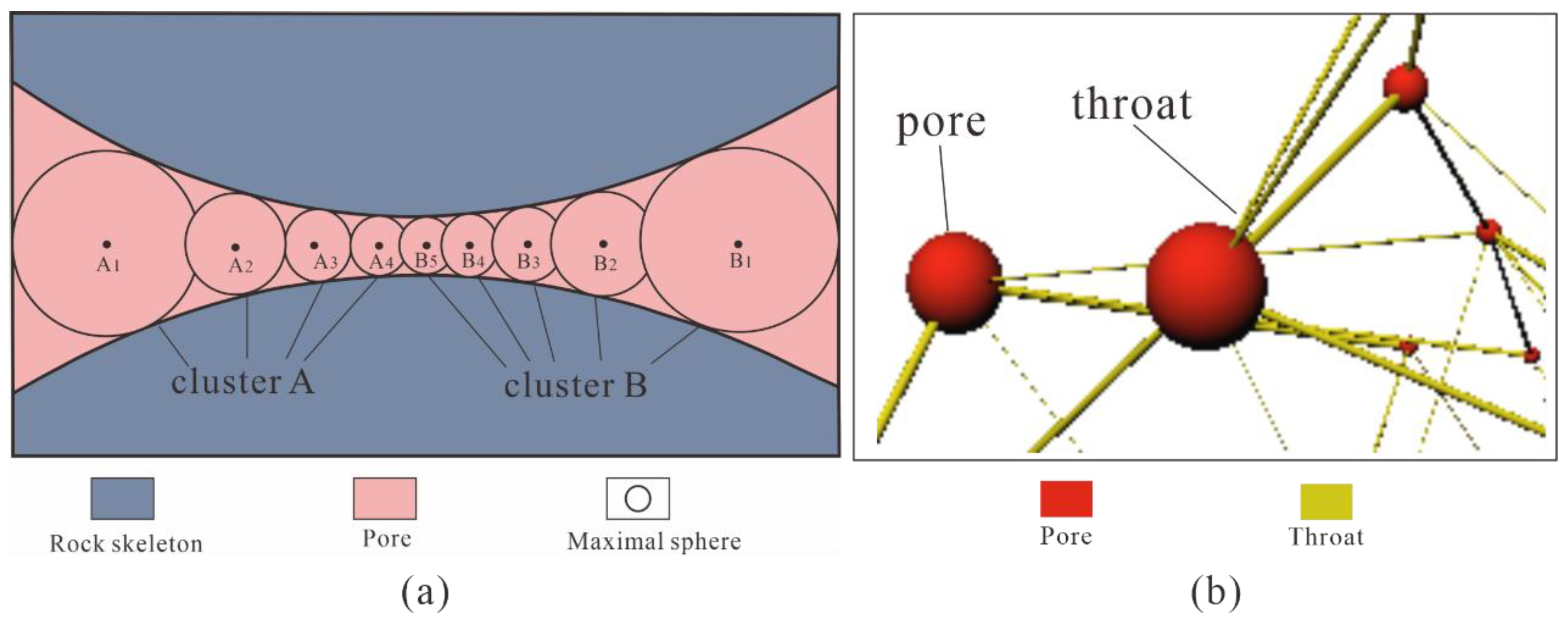
4. Results and Analysis
4.1. 3D Total Pores Distribution Model
4.2. 3D Connected Pore Segmentation Model
4.3. Pore–Throat Network Model
4.4. 3D Fracture Body Model
4.5. Natural GasSeepage Simulation
5. Discussion
5.1. Influence of Microscopic Basic Physical Properties of Volcanic Reservoir on Gas Migration
5.2. Influence of Fractures on Reservoir Connectivity and Permeability
5.3. The Influence of Integrated Pore–Throat/Fracture Analysis on Permeability
6. Conclusions
Author Contributions
Funding
Data Availability Statement
Acknowledgments
Conflicts of Interest
References
- Yao, W.J.; Chen, Z.H.; Dong, X.M.; Hu, T.T.; Liang, Z.L.; Jia, C.M.; Pan, T.; Yu, H.T.; Dang, Y.F. Storage space, pore–throat structure of igneous rocks and the significance to petroleum accumulation: An example from Junggar Basin, western China. Mar. Pet. Geol. 2021, 133, 105270. [Google Scholar] [CrossRef]
- Lewis, J.W. Occurrence of Oil in Igneous Rocks of Cuba. AAPG Bull. 1932, 16, 809–818. [Google Scholar] [CrossRef]
- Kroeger, K.F.; Bischoff, A.; Nicol, A. Petroleum systems in a buried stratovolcano: Maturation, migration and leakage. Mar. Pet. Geol. 2022, 141, 105682. [Google Scholar] [CrossRef]
- Liu, S.X.; Zhang, Y.Y.; Wu, Q.L.; Ayers, W.B.; Wang, Y.Q.; Ott, W.K.; Yan, Y.G.; Shi, W.Y.; Wang, Y. Crucial Development Technologies for Volcanic Hydrocarbon Reservoirs: Lessons Learned from Asian Operations. Processes 2023, 11, 3052. [Google Scholar] [CrossRef]
- Weydt, L.M.; Lucci, F.; Lacinska, A.; Scheuvens, D.; Carrasco–Núñez, G.; Giordano, G.; Rochelle, C.A.; Schmidt, S.; Bär, K.; Sass, I. The impact of hydrothermal alteration on the physiochemical characteristics of reservoir rocks: The case of the Los Humeros geothermal field (Mexico). Geotherm. Energy 2022, 10, 20. [Google Scholar] [CrossRef]
- Sidney, P. Notes on Minor Occurrences of Oil, Gas, and Bitumen with Igneous and Metamorphic Rocks. AAPG Bull. 1932, 16, 837–858. [Google Scholar] [CrossRef]
- Othman, R.; Arouri, K.R.; Ward, C.R.; McKirdy, D.M. Oil generation by igneous intrusions in the northern Gunnedah Basin, Australia. Org. Geochem. 2001, 32, 1219–1232. [Google Scholar] [CrossRef]
- Zhang, K.L.; Wang, Z.L.; Jiang, Y.Q.; Wang, A.G.; Xiang, B.L.; Zhou, N.; Wang, Y. Effects of weathering and fracturing on the physical properties of different types of volcanic rock: Implications for oil reservoirs of the Zhongguai relief, Junggar Basin, NW China. J. Pet. Sci. Eng. 2020, 193, 107351. [Google Scholar] [CrossRef]
- Lenhardt, N.; Götz, A.E. Volcanic settings and their reservoir potential: An outcrop analog study on the Miocene Tepoztlan Formation, Central Mexico. J. Volcanol. Geotherm. Res. 2011, 204, 66–75. [Google Scholar] [CrossRef]
- Hennings, P.; Allwardt, P.; Paul, P.; Zahm, C.; Reid, R.; Alley, H.; Kirschner, R.; Lee, B.; Hough, E. Relationship between fractures, fault zones, stress, and reservoir productivity in the Suban gas field, Sumatra, Indonesia. AAPG Bull. 2012, 96, 753–772. [Google Scholar] [CrossRef]
- Wang, P.J.; Chen, S.M. Cretaceous volcanic reservoirs and their exploration in the Songliao Basin, northeast China. AAPG Bull. 2015, 99, 499–523. [Google Scholar] [CrossRef]
- Chen, Z.H.; Wang, X.Y.; Wang, X.L.; Zhang, Y.G.; Yang, D.S.; Tang, Y. Characteristics and petroleum origin of the Carboniferous volcanic rock reservoirs in the Shixi Bulge of Junggar Basin, western China. Mar. Pet. Geol. 2017, 80, 517–537. [Google Scholar] [CrossRef]
- Li, R.; Xiong, Z.; Wang, Z.; Xie, W.; Li, W.; Hu, J. Lithofacies Characteristics and Pore Controlling Factors of New Type of Permian Unconventional Reservoir in Sichuan Basin. Processes 2023, 11, 625. [Google Scholar] [CrossRef]
- Marins, G.M.; Parizek–Silva, Y.; Millett, J.M.; Jerram, D.A.; Rossetti, L.M.M.; Souza, A.D.E.; Planke, S.; Bevilaqua, L.A.; Carmo, I.D. Characterization of volcanic reservoirs; insights from the Badejo and Linguado oil field, Campos Basin, Brazil. Mar. Pet. Geol. 2022, 146, 105950. [Google Scholar] [CrossRef]
- Feng, Z.Q. Volcanic rocks as prolific gas reservoir: A case study from the Qingshen gas field in the Songliao Basin, NE China. Mar. Pet. Geol. 2008, 25, 416–432. [Google Scholar] [CrossRef]
- Shan, X.L.; Mu, H.S.; Liu, Y.H.; Li, R.L.; Zhu, J.F.; Shi, Y.Q.; Leng, Q.L.; Yi, J. Subaqueous volcanic eruptive facies, facies model and its reservoir significance in a continental lacustrine basin: A case from the Cretaceous in Chaganhua area of southern Songliao Basin, NE China. Pet. Explor. Dev. 2023, 50, 826–839. [Google Scholar] [CrossRef]
- Zheng, H.; Sun, X.M.; Zhu, D.F.; Tian, J.X.; Wang, P.J.; Zhang, X.Q. Characteristics and factors controlling reservoir space in the Cretaceous volcanic rocks of the Hailar Basin, NE China. Mar. Pet. Geol. 2018, 91, 749–763. [Google Scholar] [CrossRef]
- Li, J.; Chen, G.P.; Zhang, B.; Hong, L.; Han, Q.F. Structure and fracture–cavity identification of epimetamorphic volcanic–sedimentary rock basement reservoir: A case study from central Hailar Basin, China. Arab. J. Geosci. 2019, 12, 64. [Google Scholar] [CrossRef]
- Wei, W.; Zhu, X.M.; Chen, D.Z.; Zhu, S.F.; He, M.W.; Sun, S.Y. Pore Fluid and Diagenetic Evolution of Carbonate Cements in Lacustrine Carbonate–Siliciclastic Rocks: A Case from the Lower Cretaceous of the Erennaoer Sag, Erlian Basin, Ne China. J. Sediment. Res. 2019, 89, 459–477. [Google Scholar] [CrossRef]
- Bian, B.; Iming, A.; Gao, T.; Liu, H.; Jiang, W.; Wang, X.; Ding, X. Petroleum Geology and Exploration of Deep–Seated Volcanic Condensate Gas Reservoir around the Penyijingxi Sag in the Junggar Basin. Processes 2022, 10, 2430. [Google Scholar] [CrossRef]
- Ma, J.; Huang, Z.L.; Liang, S.J.; Liu, Z.Z.; Liang, H. Geochemical and tight reservoir characteristics of sedimentary organic–matter–bearing tuff from the Permian Tiaohu Formation in the Santanghu Basin, Northwest China. Mar. Pet. Geol. 2016, 73, 405–418. [Google Scholar] [CrossRef]
- Ma, J.; Huang, Z.L.; Zhong, D.K.; Liang, S.J.; Liang, H.; Xue, D.Q.; Chen, X.; Fan, T.G. Formation and distribution of tuffaceous tight reservoirs in the Permian Tiaohu Formation in the Malang sag, Santanghu Basin, NW China. Pet. Explor. Dev. 2016, 43, 778–786. [Google Scholar] [CrossRef]
- Xie, Q.B.; Han, D.X.; Zhu, X.M.; Zhu, Y.X. Reservoir space feature and evolution of the volcanic rocks in the Santanghu basin. Pet. Explor. Dev. 2002, 29, 84–86+111. [Google Scholar]
- Liu, Z.; Wu, H.; Zhang, S.; Zhao, X. Study on the Reservoir Heterogeneity of Different Volcanic Facies Based on Electrical Imaging Log in the Liaohe Eastern Sag. Processes 2023, 11, 2427. [Google Scholar] [CrossRef]
- Xie, J.R.; Li, Y.; Yang, Y.M.; Zhang, B.J.; Liu, R.; He, Q.L.; Wang, W.; Wang, Y.F. Main controlling factors and natural gas exploration potential of Permian scale volcanoclastic reservoirs in the western Sichuan Basin. Nat. Gas Ind. 2021, 41, 48–57. [Google Scholar]
- Rabbel, O.; Palma, O.; Mair, K.; Galland, O.; Spacapan, J.B.; Senger, K. Fracture networks in shale–hosted igneous intrusions: Processes, distribution and implications for igneous petroleum systems. J. Struct. Geol. 2021, 150, 104403. [Google Scholar] [CrossRef]
- Tang, H.F.; Tian, Z.W.; Gao, Y.F.; Dai, X.J. Review of volcanic reservoir geology in China. Earth–Sci. Rev. 2022, 232, 104158. [Google Scholar] [CrossRef]
- Zeng, F.C.; Liu, B.; Zhang, C.M.; Zhang, G.Y.; Gao, J.; Liu, J.J.; Ostadhassan, M. Accumulation and Distribution of Natural Gas Reservoir in Volcanic Active Area: A Case Study of the Cretaceous Yingcheng Formation in the Dehui Fault Depression, Songliao Basin, NE China. Geofluids 2021, 2021, 2900224. [Google Scholar] [CrossRef]
- Gong, D.Y.; Song, Y.; Peng, M.; Liu, C.W.; Wang, R.J.; Wu, W.A. The Hydrocarbon Potential of Carboniferous Reservoirs in the Jimsar Sag, Northwest China: Implications for a Giant Volcanic–Petroleum Reserves. Front. Earth Sci. 2022, 10, 879712. [Google Scholar] [CrossRef]
- Guo, Z.; Li, Y.; Liu, C.; Zhang, D.; Li, A. Characterization of a Volcanic Gas Reservoir Using Seismic Dispersion and Fluid Mobility Attributes. Lithosphere 2021, 2021, 9520064. [Google Scholar] [CrossRef]
- Fu, L.; Qin, Z.J.; Xie, A.; Chen, L.; Li, J.F.; Wang, N.; Qin, Q.R.; Mao, K.L. The relation of the “four properties” and fluid identification of the carboniferous weathering crust volcanic reservoir in the Shixi Oilfield, Junggar Basin, China. Front. Earth Sci. 2022, 10, 983572. [Google Scholar] [CrossRef]
- Wang, W.F.; Wang, Z.Z.; Leung, J.Y.; Kong, C.X.; Jiang, Q.P. Petrophysical rock typing based on deep learning network and hierarchical clustering for volcanic reservoirs. J. Pet. Sci. Eng. 2022, 210, 110017. [Google Scholar] [CrossRef]
- Chen, J.K.; Deng, X.L.; Shan, X.; Feng, Z.Y.; Zhao, L.; Zong, X.H.; Feng, C. Intelligent Classification of Volcanic Rocks Based on Honey Badger Optimization Algorithm Enhanced Extreme Gradient Boosting Tree Model: A Case Study of Hongche Fault Zone in Junggar Basin. Processes 2024, 12, 285. [Google Scholar] [CrossRef]
- Zhao, D.D.; Hou, J.G.; Sarma, H.; Guo, W.J.; Liu, Y.M.; Xie, P.F.; Dou, L.X.; Chen, R.X.; Zhang, Z.Y. Pore throat heterogeneity of different lithofacies and diagenetic effects in gravelly braided river deposits: Implications for understanding the formation process of high–quality reservoirs. Geoenergy Sci. Eng. 2023, 221, 111309. [Google Scholar] [CrossRef]
- Du, M.; Yang, Z.M.; Jiang, E.Y.; Lv, J.R.; Yang, T.J.; Wang, W.M.; Wang, J.X.; Zhang, Y.P.; Li, H.B.; Xu, Y. Using digital cores and nuclear magnetic resonance to study pore–fracture structure and fluid mobility in tight volcanic rock reservoirs. J. Asian Earth Sci. 2024, 259, 105890. [Google Scholar] [CrossRef]
- Zhang, K.; Jiang, S.; Zhao, R.; Wang, P.F.; Jia, C.Z.; Song, Y. Connectivity of organic matter pores in the Lower Silurian Longmaxi Formation shale, Sichuan Basin, Southern China: Analyses from helium ion microscope and focused ion beam scanning electron microscope. Geol. J. 2022, 57, 1912–1924. [Google Scholar] [CrossRef]
- Hu, C.; Deng, Q.J.; Lin, L.; Hu, M.Y.; Hou, X.Y.; Zong, L.M.; Song, P.; Kane, O.I.; Cai, Q.S.; Hu, Z.G. Lower Cretaceous volcanic–sedimentary successions of the continental rift basin in the Songliao Basin, northeast China: Implication in high–quality reservoir prediction and hydrocarbon potential. Mar. Pet. Geol. 2023, 158, 106540. [Google Scholar] [CrossRef]
- Ji, P.F.; Lin, H.F.; Kong, X.G.; Li, S.G.; Hu, B.; Wang, P.; He, D.; Yang, S.R. Pore structure of low–permeability coal and its deformation characteristics during the adsorption–desorption of CH4/N2. Int. J. Coal Sci. Technol. 2023, 10, 51. [Google Scholar] [CrossRef]
- Yu, R.; Wang, Z.T.; Liu, C.; Zhang, W.L.; Zhu, Y.X.; Tang, M.M.; Che, Q.J. Microstructure and heterogeneity of coal–bearing organic shale in the southeast Ordos Basin, China: Implications for shale gas storage. Front. Earth Sci. 2022, 10, 978982. [Google Scholar] [CrossRef]
- Zhou, X.H.; Xu, G.S.; Cui, H.Y.; Zhang, W. Fracture development and hydrocarbon accumulation in tight sandstone reservoirs of the Paleogene Huagang Formation in the central reversal tectonic belt of the Xihu Sag, East China Sea. Pet. Explor. Dev. 2020, 47, 499–512. [Google Scholar] [CrossRef]
- Yoshida, N.; Shimoda, K.; Yamamura, K.; Fuse, K.; Kaminoyama, H.; Ishigami, Y.; Mhiri, A.; Niu, L.; Ramondenc, P.; Luo, Y.; et al. Unlocking the Potential of Acid Stimulation in Volcanic Rocks: A Successful Case with Integrated Analysis in Minami–Nagaoka Gas Field, Japan. Spe Prod. Oper. 2023, 38, 162–176. [Google Scholar]
- Yamamura, K.; Yoshida, N.; Shimoda, K.; Shimada, S.; Matsui, R.; Ziauddin, M. The Use of Formic Acid and Organic Mud Acid for Stimulation of Volcanic Rocks in Minami–Nagaoka Gas Field, Japan. Spe Prod. Oper. 2022, 37, 397–413. [Google Scholar] [CrossRef]
- Vieira, L.D.; Moreira, A.C.; Mantovani, I.F.; Honorato, A.R.; Prado, O.F.; Becker, M.; Fernandes, C.P.; Waichel, B.L. The influence of secondary processes on the porosity of volcanic rocks: A multiscale analysis using 3D X–ray microtomography. Appl. Radiat. Isot. 2021, 172, 109657. [Google Scholar] [CrossRef] [PubMed]
- Qin, Z.; Pang, W.L.; Mao, W.Z.; Han, J.H.; Li, Z.W.; Yao, Y.J. Study on seepage characteristics and stress sensitivity of sandstone under cyclic water intrusion based on CT scanning technique. Bull. Eng. Geol. Environ. 2023, 82, 271. [Google Scholar] [CrossRef]
- Ma, J.; Querci, L.; Hattendorf, B.; Saar, M.O.; Kong, X.Z. The Effect of Mineral Dissolution on the Effective Stress Law for Permeability in a Tight Sandstone. Geophys. Res. Lett. 2020, 47, e2020GL088346. [Google Scholar] [CrossRef]
- Chen, X.; Qi, M.H.; Deng, X.; Cao, Q. Mineral Composition Characteristics and Its Controlling Factors in Shale of Chang 7 Member of Yanchang Formation in the South of Ordos Basin. Sci. Technol. Eng. 2023, 23, 9460–9469. [Google Scholar] [CrossRef]
- Fu, J.; Li, h.; Niu, X.; Deng, X.; Zhou, X. Geological characteristics and exploration of shale oil in Chang 7 Member of Triassic Yanchang Formation, Ordos Basin, NW China. Pet. Explor. Dev. 2020, 47, 870–883. [Google Scholar] [CrossRef]
- Fan, N.; Wang, J.R.; Deng, C.B.; Fan, Y.P.; Wang, T.T.; Guo, X.Y. Quantitative characterization of coal microstructure and visualization seepage of macropores using CT–based 3D reconstruction. J. Nat. Gas Sci. Eng. 2020, 81, 103384. [Google Scholar] [CrossRef]
- Liu, W.Z.; Niu, S.W.; Tang, H.B. Structural characteristics of pores and fractures during lignite pyrolysis obtained from X–ray computed tomography. J. Pet. Sci. Eng. 2023, 220, 111150. [Google Scholar] [CrossRef]
- Heap, M.J.; Reuschlé, T.; Farquharson, J.I.; Baud, P. Permeability of volcanic rocks to gas and water. J. Volcanol. Geotherm. Res. 2018, 354, 29–38. [Google Scholar] [CrossRef]
- Lu, F.F.; Tan, X.C.; Xiao, D.; Shi, K.B.; Li, M.L.; Zhang, Y.; Zheng, H.F.; Dong, Y.X. Sedimentary control on diagenetic paths of dolomite reservoirs in a volcanic setting: A case study of the Permian Chihsia Formation in the Sichuan Basin, China. Sediment. Geol. 2023, 454, 106451. [Google Scholar] [CrossRef]
- Mao, Z.G.; Zhu, R.K.; Wang, J.H.; Luo, J.L.; Su, L. Characteristics of Diagenesis and Pore Evolution of Volcanic Reservoir: A Case Study of Junggar Basin, Northwest China. J. Earth Sci. 2021, 32, 960–971. [Google Scholar] [CrossRef]
- Wang, X.C.; Chen, W.T.; He, Y.; Liu, H.Q.; Wang, W.Y. Control of Paleocene volcanic edifice on favorable reservoirs: A case study of the southwestern Huizhou Sag, Pearl River Mouth Basin. Pet. Geol. Exp. 2022, 44, 466–475. [Google Scholar] [CrossRef]
- Tie, S.W.; Shan, L.Y.; Regis, K.L.A.; Hui, L.Z.; Liang, Z.; Mei, W.H. Classification and Evaluation of Volcanic Rock Reservoirs Based on the Constraints of Energy Storage Coefficient. Front. Earth Sci. 2022, 10. [Google Scholar] [CrossRef]
- Hu, S.Y.; Wang, X.J.; Cao, Z.L.; Li, J.Z.; Gong, D.Y.; Xu, Y. Formation conditions and exploration direction of large and medium gas reservoirs in the Junggar Basin, NW China. Pet. Explor. Dev. 2020, 47, 266–279. [Google Scholar] [CrossRef]
- Wang, J.M.; Yang, B.J.; Li, Z.L.; Yu, C.L.; Jiang, C.J.; Li, P.; Cao, L.S.; Chen, Z. Crustal structure between the eastern margin of the Songliao Basin and its geological implication: Deep seismic reflection. Chin. J. Geophys. 2020, 63, 3478–3490. [Google Scholar] [CrossRef]
- Liu, Z.H.; Song, J.; Liu, X.W.; Wu, X.M.; Gao, X. Discovery of the Cretaceous–Paleogene compressional structure and basin properties of the southern Songliao Basin. Acta Pet. Sin. 2020, 36, 2383–2393. [Google Scholar] [CrossRef]
- Zhang, J.F.; Xu, X.Y.; Bai, J.; Liu, W.B.; Chen, S.; Liu, C.; Li, Y.H. Enrichment and exploration of deep lacustrine shale oil in the first member of Cretaceous Qingshankou Formation, southern Songliao Basin, NE China. Pet. Explor. Dev. 2020, 47, 683–698. [Google Scholar]
- Liu, C.; Nicotra, E.; Shan, X.; Yi, J.; Ventura, G. The Cretaceous volcanism of the Songliao Basin: Mantle sources, magma evolution processes and implications for the NE China geodynamics—A review. Earth–Sci. Rev. 2023, 237, 104294. [Google Scholar] [CrossRef]
- Yang, X.B.; Wang, H.Y.; Li, Z.Y.; Guan, C.; Wang, X. Tectonic–sedimentary evolution of a continental rift basin: A case study of the Early Cretaceous Changling and Lishu fault depressions, southern Songliao Basin, China. Mar. Pet. Geol. 2021, 128, 105068. [Google Scholar] [CrossRef]
- Zhang, H.; Wang, X.J.; Jia, C.Z.; Li, J.H.; Meng, Q.A.; Jiang, L.; Wang, Y.Z.; Bai, X.F.; Zheng, Q. Whole petroleum system and hydrocarbon accumulation model in shallow and medium strata in northern Songliao Basin, NE China. Pet. Explor. Dev. 2023, 50, 784–797. [Google Scholar] [CrossRef]
- Xu, Z.J.; Jiang, S.; Liu, L.F.; Wu, K.J.; Li, R.; Liu, Z.Y.; Shao, M.L.; Jia, K.X.; Feng, Y.J. Natural gas accumulation processes of tight sandstone reservoirs in deep formations of Songliao Basin, NE China. J. Nat. Gas Sci. Eng. 2020, 83, 103610. [Google Scholar] [CrossRef]
- Yang, X.B.; Wang, H.Y.; Zhang, Z.H.; Wang, J.; Shi, N.; Zhang, H.Y.; Liu, A. Evolutionary characteristics and key controlling factors of the volcanic rocks in the Lower Cretaceous Changling fault depression, Songliao Basin, China. Mar. Pet. Geol. 2023, 153, 106263. [Google Scholar] [CrossRef]
- Mu, H.S.; Li, R.L.; Zhu, J.F.; Xu, W.; Qu, X.Y. Spatial Characteristics and Genesis of Tight Clastic Reservoirs in Yingcheng Formation of Changling Fault Depression in the Southern Songliao Basin. Geofluids 2022, 2022, 5852119. [Google Scholar] [CrossRef]
- Wang, Y.X.; Zhang, W.M.; Cong, Y.M.; Zhou, J.H.; Ding, Y.; Wang, Z.J. The fault characteristics of the Wangfu fault depression and its controlling effects on deep–seated volcanic gas reservoir. Acta Pet. Sin. 2018, 34, 2189–2199. [Google Scholar]
- Wang, T.T.; Wang, C.S.; Ramezani, J.; Wan, X.Q.; Yu, Z.Q.; Gao, Y.F.; He, H.Y.; Wu, H.C. High–precision geochronology of the Early Cretaceous Yingcheng Formation and its stratigraphic implications for Songliao Basin, China. Geosci. Front. 2022, 13, 101386. [Google Scholar] [CrossRef]
- Xi, K.; Cao, Y.; Jahren, J.; Zhu, R.; Bjorlykke, K.; Zhang, X.; Cai, L.; Hellevang, H. Quartz cement and its origin in tight sandstone reservoirs of the Cretaceous Quantou formation in the southern Songliao basin, China. Mar. Pet. Geol. 2015, 66, 748–763. [Google Scholar] [CrossRef]
- Withers, P.J.; Bouman, C.; Carmignato, S.; Cnudde, V.; Grimaldi, D.; Hagen, C.K.; Maire, E.; Manley, M.; Du Plessis, A.; Stock, S.R. X–ray computed tomography. Nat. Rev. Methods Primers 2021, 1, 18. [Google Scholar] [CrossRef]
- Iraji, S.; Soltanmohammadi, R.; Munoz, E.R.; Basso, M.; Vidal, A.C. Core scale investigation of fluid flow in the heterogeneous porous media based on X–ray computed tomography images: Upscaling and history matching approaches. Geoenergy Sci. Eng. 2023, 225, 211716. [Google Scholar] [CrossRef]
- Iraji, S.; De Almeida, T.R.; Munoz, E.R.; Basso, M.; Vidal, A.C. The impact of heterogeneity and pore network characteristics on single and multi–phase fluid propagation in complex porous media: An X–ray computed tomography study. Pet. Sci. 2024, 21, 1719–1738. [Google Scholar] [CrossRef]
- Tan, K.J.; Zhao, J.G.; Teng, T.Y.; Liu, X.Z.; Yan, B.H. Research on effectiveness of effective pore aspect ratio based on pore–throat characteristics of digital core. Chin. J. Geophys. 2022, 65, 4433–4447. [Google Scholar] [CrossRef]
- Xie, C.Y.; Zhang, W.; Yao, D.F.; Wang, J.; Zhu, Y.C. Quantitative Characterization of Spatial Pore Network of Soils Based on Maximal–Balls Algorithm. J. Eng. Geol. 2019, 28, 60–68. [Google Scholar]
- Luo, Y.; Wang, Y.; Wang, R.; Yuan, W. Construction and analysis of pore–fracture network model of carbonate rock. Xinjiang Pet. Geol. 2021, 42, 107–112. [Google Scholar]
- Xiao, D.A.S.; Gao, Y.; Peng, S.C.; Wang, M.; Wang, M.; Lu, S.F. Classification and control factors of pore–throat systems in hybrid sedimentary rocks of Jimusar Sag, Junggar Basin, NW China. Pet. Explor. Dev. 2021, 48, 835–849. [Google Scholar] [CrossRef]
- Guo, Z.; Zhang, X.; Liu, C.; Liu, X.; Liu, Y. Hydrocarbon Identification and Bedding Fracture Detection in Shale Gas Reservoirs Based on a Novel Seismic Dispersion Attribute Inversion Method. Surv. Geophys. 2022, 43, 1793–1816. [Google Scholar] [CrossRef]
- Xu, J.L.; Wang, R.T.; Zan, L.; Wang, X.G.; Huo, J.Q. Geomechanical log responses and identification of fractures in tight sandstone, West Sichuan Xinchang Gas Field. Sci. Rep. 2022, 12, 15543. [Google Scholar] [CrossRef]
- Zhao, L. Development characteristics of microfractures in tight sandstone reservoir and its influence on physical properties: A case study of Shiligiahan zone in Hangjinqi. Pet. Reserv. Eval. Dev. 2022, 12, 285–291+312. [Google Scholar]
- Wang, Y.S.; Gao, Y.; Fang, Z.W. Pore throat structure and classification of Paleogene tight reservoirs in Jiyang depression, Bohai Bay Basin, China. Pet. Explor. Dev. 2021, 48, 308–322. [Google Scholar] [CrossRef]
- Dong, L.P.; Nie, Q.H.; Sun, X.K.; Cao, W.F.; Kou, D.T.; Bai, Z.Q.; Yang, S.N. Analysis of Impact of Shield Tunneling Parameters on Ground Settlement Based on Pearson Correlation Coefficient Method. Constr. Technol. 2024, 53, 116–123. [Google Scholar]
- Li, L.; Shi, G.Y.; Zhang, Y.X.; Liu, X.W. Relationship between the heterogeneity of low–permeability reservoirs and the dynamic evolution of fractures under uniaxial compression conditions by CT scanning: A case study in the jiyang depression of Bohai Bay Basin, China. Front. Earth Sci. 2023, 10, 1018561. [Google Scholar] [CrossRef]
- Zhong, G.M.; Shi, L.; Zhao, X.Y.; Mao, Y.Q.; Li, Y.G.; Guo, Y.H.; Wu, L.; Zheng, T.L. Quality evaluation of altered volcaniclastic rock reservoirs in the Changling fault depression of the southern Songliao Basin. Nat. Gas Ind. 2023, 43, 25–36. [Google Scholar]
- Guo, Z.; Zhang, X.; Liu, C. An Improved Scheme of Azimuthally Anisotropic Seismic Inversion for Fracture Prediction in Volcanic Gas Reservoirs. IEEE Trans. Geosci. Remote Sens. 2022, 60, 5917312. [Google Scholar] [CrossRef]
- Luo, Q.; Tang, H.F.; Liu, Q.M.; Yin, Y.S.; Wang, L.X.; Shang, H.J. Multi–scale fracture modeling method and its application: A case study of tight sandstone reservoir in Keshen 2 gas field. Nat. Gas Geosci. 2023, 35, 1000–1013. [Google Scholar]
- Zhang, Y.B.; Xu, Y.D.; Liu, X.X.; Yao, X.L.; Wang, S.; Liang, P.; Sun, L.; Tian, B.Z. Quantitative characterization and mesoscopic study of propagation and evolution of three–dimensional rock fractures based on CT. Rock. Soil. Mech. 2021, 42, 2659–2671. [Google Scholar]
- Fang, H.H.; Sang, S.X.; Du, Y.; Liu, H.H.; Xu, H.J. Visualization characterization of minerals touched by interconnected pores and fractures and its demineralization effect on coal permeability during CO2–ECBM process based on X–ray CT data. J. Nat. Gas Sci. Eng. 2021, 95, 104213. [Google Scholar] [CrossRef]
- Qi, C.Y.; Liu, Y.; Dong, F.J.; Liu, X.X.; Yang, X.; Shen, Y.; Huang, H. Study on Heterogeneity of Pore Throats at Different Scales and Its Influence on Seepage Capacity in Different Types of Tight Carbonate Reservoirs. Geofluids 2020, 2020, 6657660. [Google Scholar] [CrossRef]
- Qu, Y.Q.; Sun, W.; Wu, H.N.; Huang, S.J.; Li, T.; Ren, D.Z.; Chen, B. Impacts of pore–throat spaces on movable fluid: Implications for understanding the tight oil exploitation process. Mar. Pet. Geol. 2022, 137, 105509. [Google Scholar] [CrossRef]
- Wu, Y.P.; Liu, C.L.; Ouyang, S.Q.; Luo, B.; Zhao, D.D.; Sun, W.; Awan, R.S.; Lu, Z.D.; Li, G.X.; Zang, Q.B. Investigation of pore–throat structure and fractal characteristics of tight sandstones using HPMI, CRMI, and NMR methods: A case study of the lower Shihezi Formation in the Sulige area, Ordos Basin. J. Pet. Sci. Eng. 2022, 210, 110053. [Google Scholar] [CrossRef]
- Chen, G.W.; Song, L.; Zhang, W.L. Numerical study on the effects of fracture parameters on permeability in fractured rock with extremely low matrix permeability. Acta Geod. Geophys. 2021, 56, 373–386. [Google Scholar] [CrossRef]
- Lu, X.F.; Dong, F.J.; Wei, X.L.; Wang, P.T.; Liu, N.; Ren, D.Z. Analysis of Microscopic Main Controlling Factors for Occurrence of Movable Fluid in Tight Sandstone Gas Reservoirs Based on Improved Grey Correlation Theory. Math. Probl. Eng. 2021, 2021, 3158504. [Google Scholar] [CrossRef]
- Wasim, M.; Mahmoodian, M.; Robert, D.; Li, C.Q. Correlation Model for the Corrosion Rates of Buried Cast Iron Pipes. J. Mater. Civ. Eng. 2020, 32, 04020353. [Google Scholar] [CrossRef]

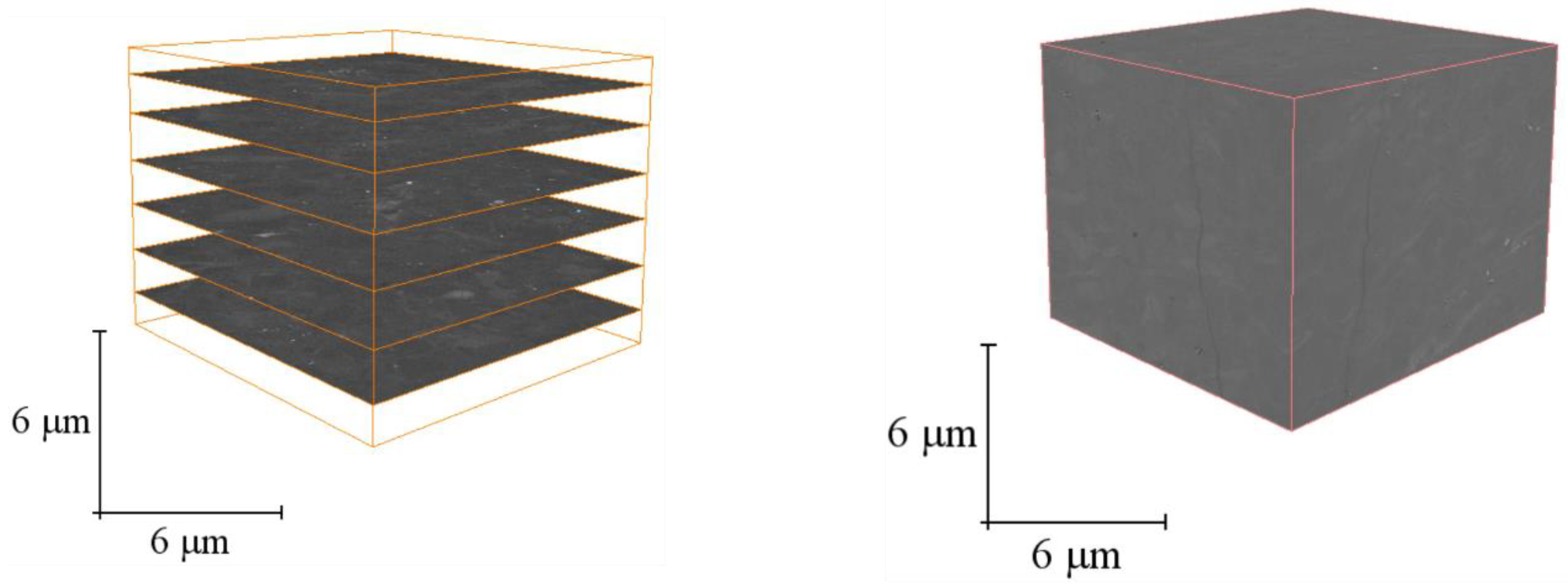
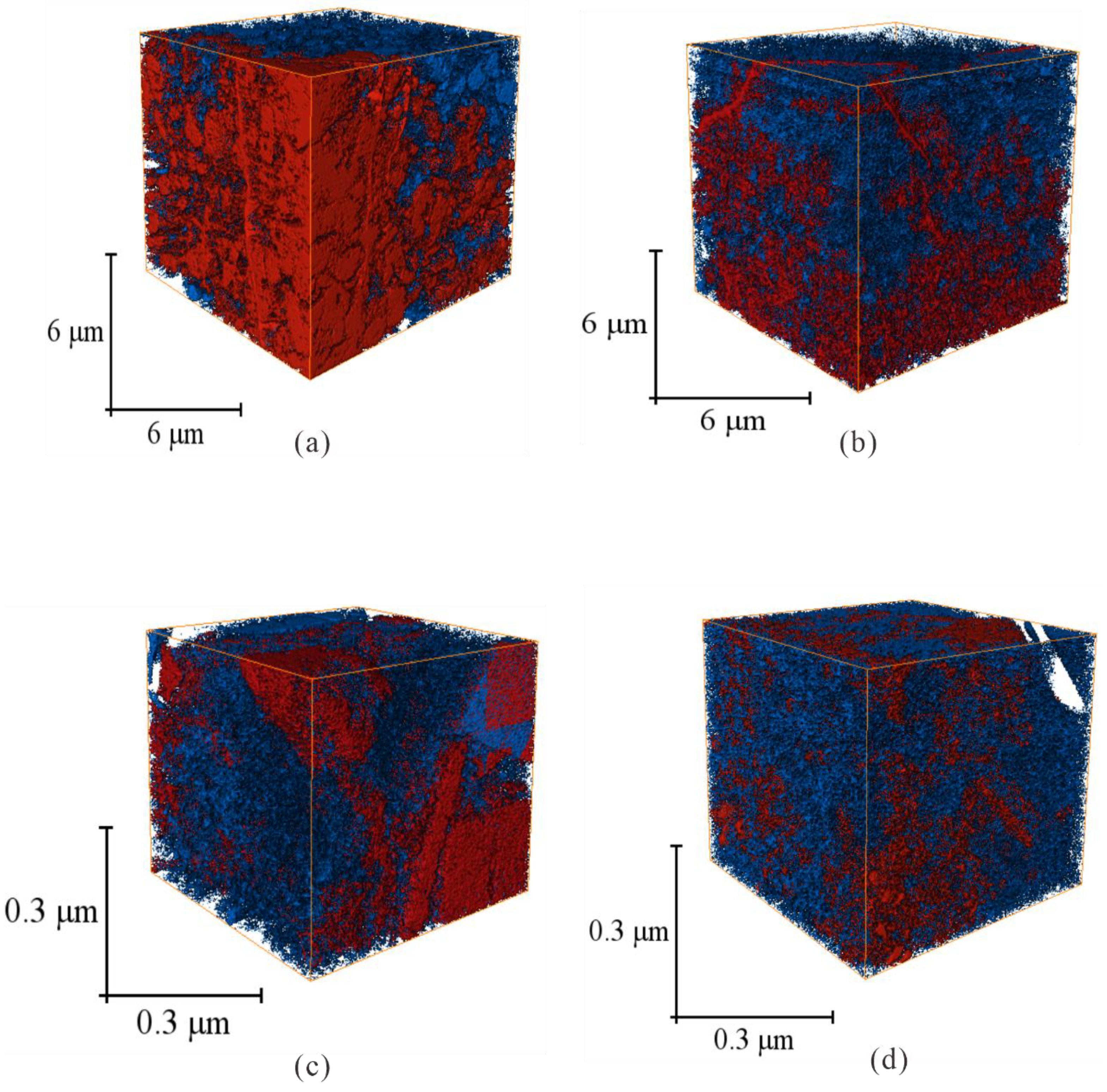


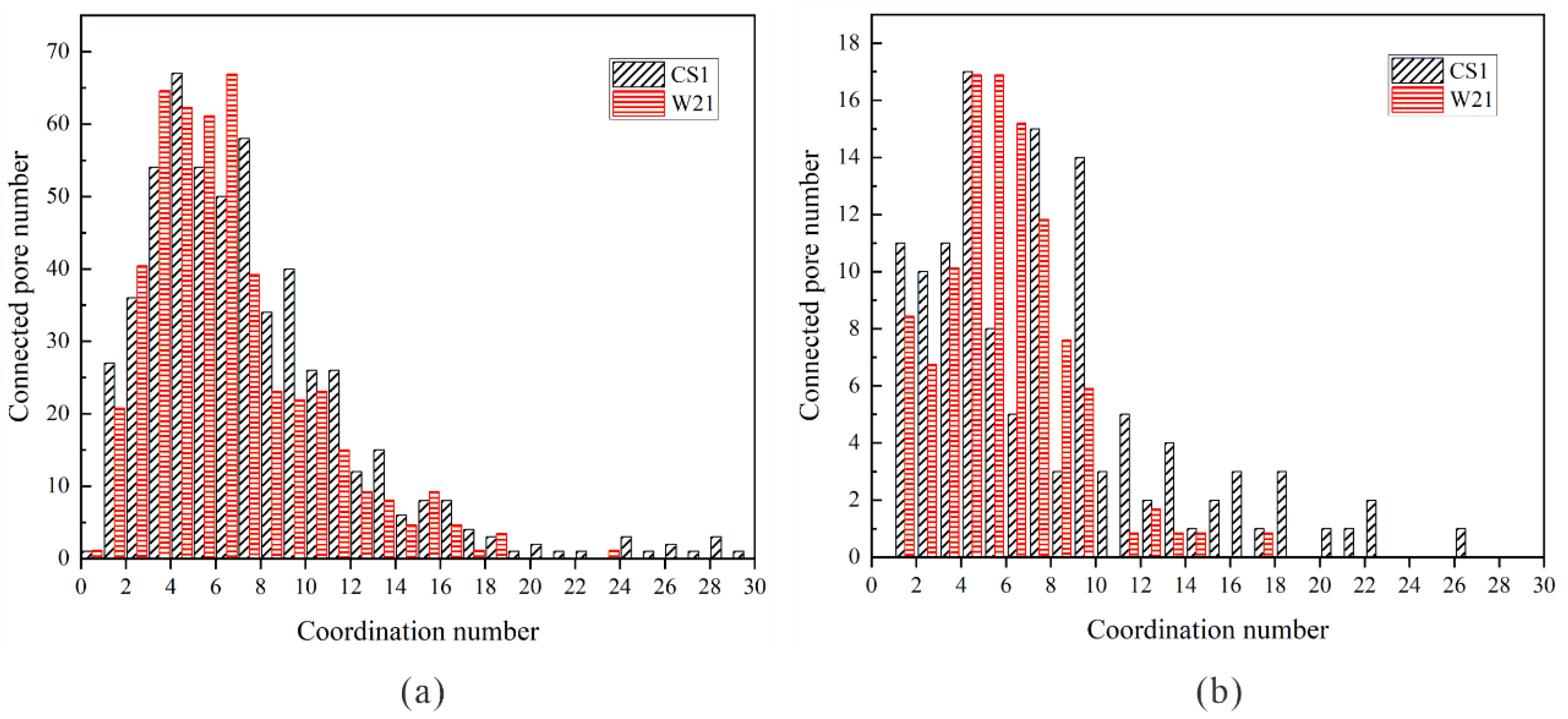




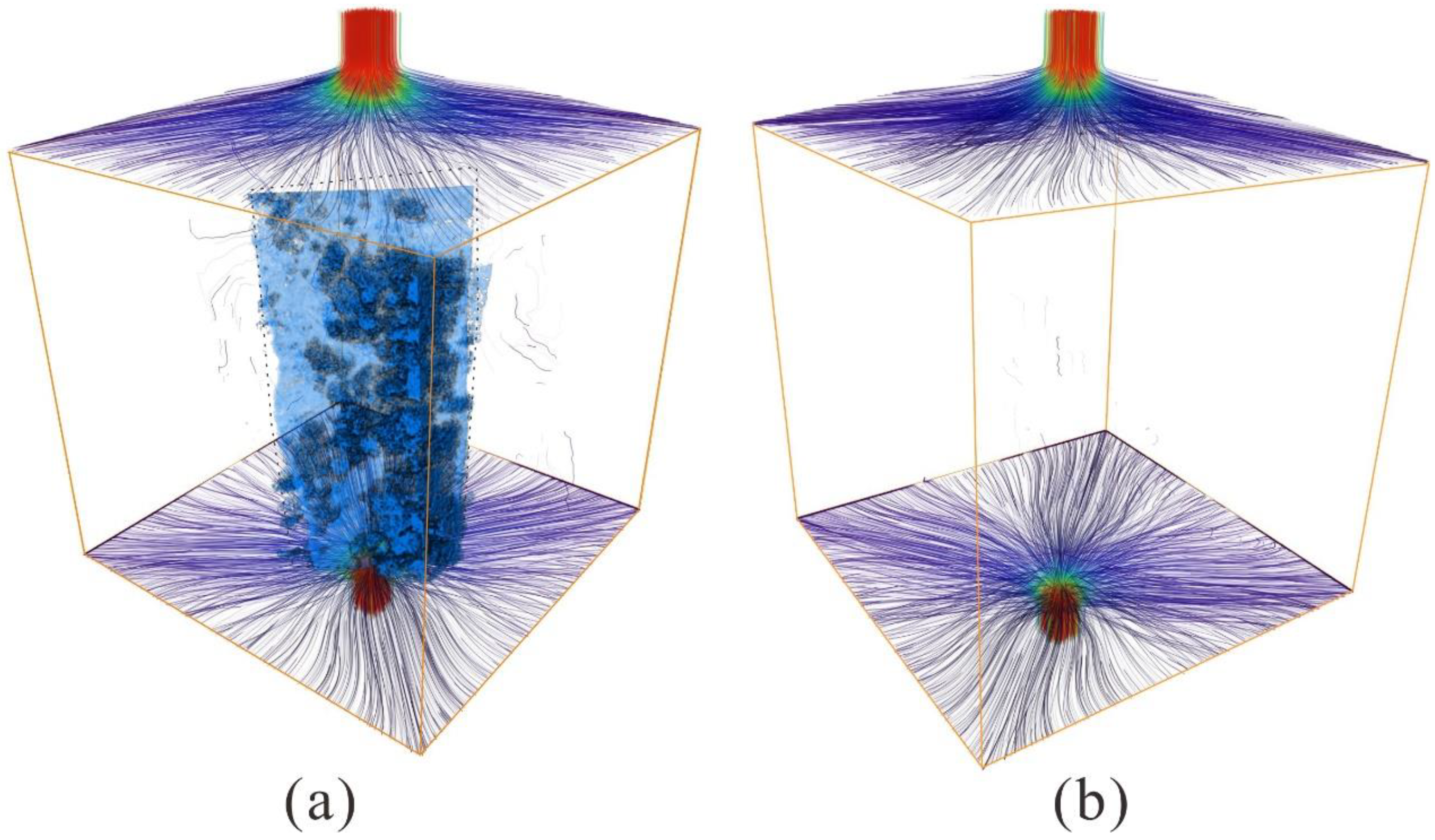
| Well | Depth (m) | Lithology | Dimensions (cm) | Permeability (mD) | Porosity (%) | CH4 Diffusion Coefficient (cm2/s) |
|---|---|---|---|---|---|---|
| CS1 | 3754.15 | Rhyolite type crystal tuff | 2.5 | 0.11 | 12.6 | 7.66 × 10–6 |
| W21 | 1399.00 | Crystalline tuff | 0.1 | 0.02 | 5.4 | 1.51 × 10–6 |
| CT Type | Sample | Total Throat | Mean Length (μm) | Mean Radius (μm) | Mean Area (μm2) |
|---|---|---|---|---|---|
| Micro–CT | CS1 | 1953 | 1.14 | 0.09 | 0.05 |
| W21 | 1259 | 1.08 | 0.07 | 0.02 | |
| Nano–CT | CS1 | 476 | 0.12 | 9.6 × 10−3 | 4.8 × 10−4 |
| W21 | 331 | 0.09 | 2.9 × 10−3 | 4.0 × 10−5 |
| Parameter | Relevance (CS1) | Relevance (W21) | Order |
|---|---|---|---|
| Average throat radius | 0.71 | 0.77 | 1 |
| Average throat length | 0.44 | 0.48 | 3 |
| Average coordination number | 0.35 | 0.31 | 4 |
| Average pore radius | 0.63 | 0.59 | 2 |
Disclaimer/Publisher’s Note: The statements, opinions and data contained in all publications are solely those of the individual author(s) and contributor(s) and not of MDPI and/or the editor(s). MDPI and/or the editor(s) disclaim responsibility for any injury to people or property resulting from any ideas, methods, instructions or products referred to in the content. |
© 2024 by the authors. Licensee MDPI, Basel, Switzerland. This article is an open access article distributed under the terms and conditions of the Creative Commons Attribution (CC BY) license (https://creativecommons.org/licenses/by/4.0/).
Share and Cite
Gao, X.; Yu, Y.; Xu, Z.; Liu, Y. Micro–Nano 3D CT Scanning to Assess the Impact of Microparameters of Volcanic Reservoirs on Gas Migration. Processes 2024, 12, 2000. https://doi.org/10.3390/pr12092000
Gao X, Yu Y, Xu Z, Liu Y. Micro–Nano 3D CT Scanning to Assess the Impact of Microparameters of Volcanic Reservoirs on Gas Migration. Processes. 2024; 12(9):2000. https://doi.org/10.3390/pr12092000
Chicago/Turabian StyleGao, Xiangwei, Yunliang Yu, Zhongjie Xu, and Yingchun Liu. 2024. "Micro–Nano 3D CT Scanning to Assess the Impact of Microparameters of Volcanic Reservoirs on Gas Migration" Processes 12, no. 9: 2000. https://doi.org/10.3390/pr12092000
APA StyleGao, X., Yu, Y., Xu, Z., & Liu, Y. (2024). Micro–Nano 3D CT Scanning to Assess the Impact of Microparameters of Volcanic Reservoirs on Gas Migration. Processes, 12(9), 2000. https://doi.org/10.3390/pr12092000





